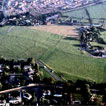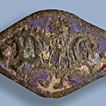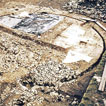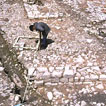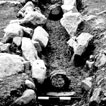The Countryside
In Roman times most people lived in the countryside. In comparison with England, Roman Wales has been little studied and there is still much that we do not know. The easiest sites to locate are settlements - but only if the people who lived there were using a lot of Roman pottery. There is some evidence that at least some people at the bottom of the social pyramid did not use many consumer goods (visit Roman Trade). Recent work on the English side of the Bristol Channel has shown that the same thing was happening there. These people would have been living in very much the same way as their Iron Age ancestors, and the only way we can tell them apart is if we find a few pieces of pottery, or if we can obtain radiocarbon dates from charcoal or bone.
The rural sites that have been excavated suggest that it was a landscape of scattered farms. Some of these were surrounded by clusters of paddocks or small fields - as there is very little evidence for larger areas of fields, the farmers may have been ranching cattle and sheep. Many of the farmsteads were on sites that had been occupied in the Iron Age, although it is not always possible to show that people were living there continuously, particularly if only a part of the settlement has been excavated. One of the best understood is at Whitton in the Vale of Glamorgan. In the Iron Age and early Roman period, this farmstead consisted of a square enclosure surrounded by a bank and ditch and containing varying number of roundhouses. The first stone building was put up around the middle of the 2nd century, and it was followed by others, until stone buildings with tiled roofs had been constructed round three sides of the enclosure. These were comfortable buildings with painted plaster on the wall and piped water, but not as grand as those on other villa sites, like the much larger one at Llantwit Major, which also had mosaic floors and underfloor central heating.
Not all people in the countryside bought into the Roman way of life to the same extent. At the same time as the inhabitants of Whitton were putting up their first stone building, a farmstead which probably contained timber roundhouses within a wooden palisade was being built five miles away at Biglis on the outskirts of Barry, on the site of a 1st century cluster of roundhouses. In the late 3rd century the roundhouses seem to have been replaced by buildings on insubstantial stone rafts and the palisade was replaced by a bank. Although the buildings at Biglis were much less sophisticated than those at Whitton, the inhabitants were well supplied with consumer goods, including lots of pottery and some very nice bronze jewellery. Study of the animal bones showed that there was obviously sufficient fodder for stock to be over-wintered.
